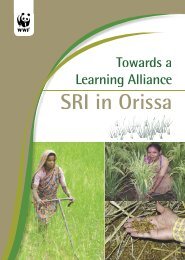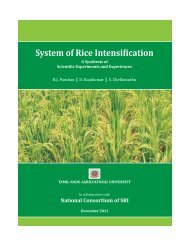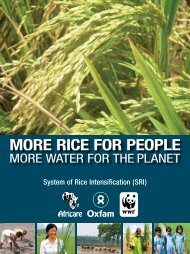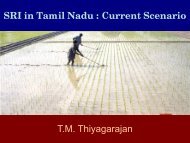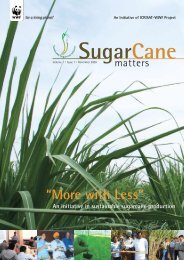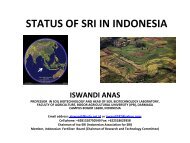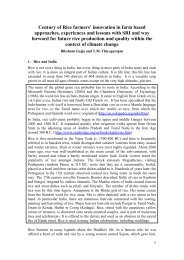Sustainable Sugarcane Initiative (SSI) manual - SRI - India
Sustainable Sugarcane Initiative (SSI) manual - SRI - India
Sustainable Sugarcane Initiative (SSI) manual - SRI - India
Create successful ePaper yourself
Turn your PDF publications into a flip-book with our unique Google optimized e-Paper software.
emoved from the polythene sheet and kept side by side in beds<br />
on the ground (see Annexure for the details on arrangement<br />
of trays) to facilitate watering and other nursery management<br />
practices.<br />
• Based on the moisture content of coco-pith, watering to the<br />
trays (seedlings) has to be initiated in the evenings for the next<br />
15 days using rose cans. Shoots will start growing strong and<br />
leaves will start sprouting. After appearance of two leaves,<br />
application of water can be increased gradually depending on<br />
moisture level in trays.<br />
Grading of the plants in trays<br />
If the coco-pith<br />
in the cone is<br />
dry, water can be<br />
applied. If it is<br />
sticky application of<br />
water can<br />
be delayed.<br />
Excess water may<br />
lead to death of<br />
shoots. So, give<br />
less water even while<br />
using rose cans.<br />
• During six leaf stage (about 20 days old seedling), grading of the<br />
plants has to be done. Stop giving water for a day to loosen the<br />
coco-pith in the trays, this enables easy lifting up of the young<br />
seedlings.<br />
• Plants of similar age (height) can be lifted up and placed in<br />
one tray. This way grading of plants according to their height is<br />
achieved and damaged or dead plants can be removed.<br />
4. Main field preparation<br />
The main field preparation in <strong>SSI</strong> method is similar to that of<br />
conventional method. A good land preparation approach should<br />
involve the following essential steps.<br />
4.1 Removal of residues<br />
Main land preparation for sugarcane starts with clearing the preceding<br />
crop residues. Stubbles are to be collected and removed from the<br />
field. All residues can be incorporated into soil by a rotavator.<br />
4.2 Tillage<br />
Tillage operations through tractor drawn implements are most<br />
ideal and quick. After one or two initial ploughings, soil must be<br />
allowed to weather for a week or two before going for further<br />
tillage operations.<br />
Tillage operation<br />
• Tillage operations can be carried out using harrows or rotavator.<br />
The operations are to be repeated to make the soil bed free from<br />
clods, weeds and crop residues.<br />
Deep ploughing of<br />
10 to 12 inches is<br />
essential to<br />
facilitate better<br />
aeration and<br />
infiltration of water<br />
into the soil.<br />
• After tillage operation, the field should be deep ploughed using<br />
a tractor.<br />
• If the field is uneven, leveling has to be done using a<br />
tractor operated leveler. While leveling, a gentle slope<br />
can be maintained to facilitate easy movement of<br />
irrigation water.<br />
18 <strong>Sustainable</strong> <strong>Sugarcane</strong> <strong>Initiative</strong>





